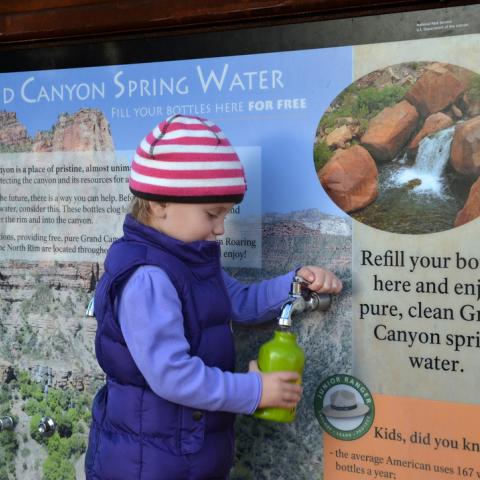
Water conservation measures are back in place for the South Rim of Grand Canyon National Park/Rebecca Latson file
Grand Canyon National Park's up again, down again water system is down again, forcing water conservation measures for the South Rim.
A park release Sunday said the move back to water conservation was forced by failure of a pump at Havasupai Gardens. Under the conservation measures, all park residents and visitors are asked to reduce water usage wherever possible. Mandatory conservation measures include:
- No watering lawns or plants.
- No washing cars, boats, bikes, or any other outside vehicle.
- Scrape food items off dishes before washing them.
- Fill the sink with water while washing dishes to avoid running water.
- Take shorter or less frequent showers.
- Turn water off while you brush your teeth.
- Reduce toilet flushing to the minimum needed.
- Report drips, leaks, or other water loss.
Backcountry travelers should plan to carry all their water or have ways to treat water they obtain from springs or the Colorado River.
Concessions operations are required to:
- Alter menus to use less water for food prep and dish washing.
- Adopt low water use for hotel room cleaning.
- Serve drinking water in restaurants by request only.
Water conservation measures were in place during the last two weeks of July following a break in the Transcanyon pipeline. Work on rebuilding the aged pipeline began last year.
Rebuilding the transcanyon waterline, at a projected cost of $208 million, involves upgrades to the associated water delivery system within the inner canyon and South Rim. This critical investment will ensure the park is able to meet water supply needs for the next 50 plus years, supporting 6 million annual visitors and approximately 2,500 year-round residents, accoriding to a park release.
The Park Service is replacing the pipeline because it is beyond its expected useful life, experiences frequent failures, and requires expensive and continuous inner canyon maintenance work to repair leaks. Since 2010, there have been more than 85 major breaks in the pipeline that have disrupted water delivery. Costs for a single isolated break often exceed $25,000. Conditions in the inner canyon include extreme terrain and high temperatures, which increase risk to employees during repair operations. The system also supplies water for fire suppression for all South Rim and inner canyon facilities, including more than 800 buildings listed in the National Register of Historic Places.
Originally built in the 1960s, the pipeline is a 12 ½-mile waterline that provides the potable water for all facilities on the South Rim and inner canyon facilities within the park. The rehabilitation project will move the water intake for the system from Roaring Springs to Bright Angel Creek near Phantom Ranch. This location will greatly reduce the length of the pipeline and eliminate a portion of the current waterline north of Phantom Ranch that experiences the most frequent failures. The water intake at Roaring Springs will continue to provide water to the North Rim.




 Support Essential Coverage of Essential Places
Support Essential Coverage of Essential Places







Comments
Is the NPS required to use side-canyon streamwater because it has no right to Colorado River water?